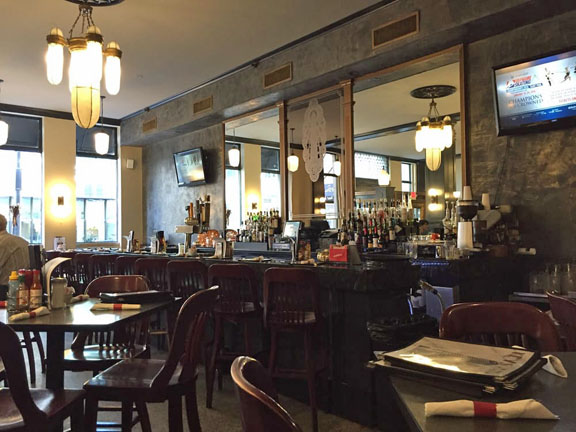Foshay Tower
Much has been written about the Foshay Tower, the first and most beloved skyscraper in Minneapolis, located at 114 So. 9th Street. I won’t go into its history here, except to say that it was built in 1929 by Wilbur B. Foshay, to emulate the Washington Monument. Brian Marsh found a photo of the bottom section in 1928, before the tower was built:
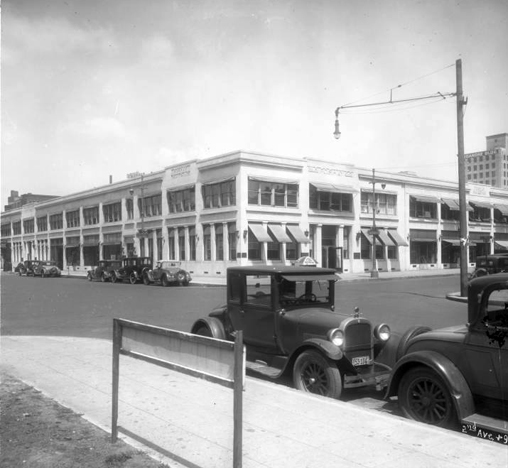
Photo courtesy Hennepin County Library
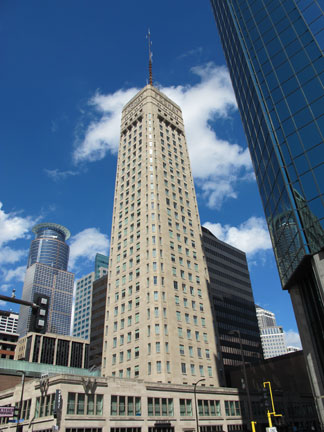
Photo from 2014 courtesy Stephen Raymer
After serving as an office building for decades, it is now a luxury hotel. Several clubs have taken a shot at the space on the first floor of this iconic building over the years.
FIVE O’CLOCK CLUB
There were Five O’Clock Clubs all over the country. Minneapolis had Five O’Clock Clubs in two locations. Not to be confused with Jimmy Delmont’s radio show of the same name on WTCN!
SKID ROW
The first Five O’Clock Club was located at 34 So. 5th Street, on Minneapolis’s Skid Row. It was one of the last of the bars to be demolished for the Gateway revitalization.
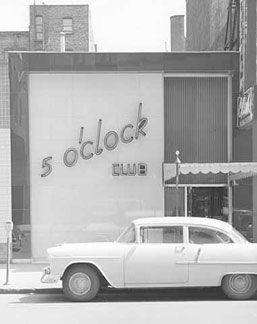
I’m guessing this is the Fifth Street location.
There was an item about two former owners being involved in a sugar black marketing scheme in 1947, but it is unclear whether they were owners of this particular club.
In 1953, E.R. Kibler of Hallet and Carey grain brokers was said to operate the club.
And in the early 1960s, Danny LaBarre and Fran Davies owned the club.
Clearance of the Gateway required the club to be demolished, and all fixtures were sold in April of 1962.
FOSHAY TOWER
LaBarre and Davies moved the club to the Foshay Tower in April or June 1963.
The Five O’Clock Club was later owned by Manny De Silva. In October 1963 Manny was billed as a popular romantic singing idol. From 1963-69 Manny sang at Ferrara’s as well.
The Five O’Clock Club was gone from the Foshay Tower by January 1965.
KING SOLOMON’S MINES
King Solomon’s Mines was owned by dance instructor Dean Constantine.
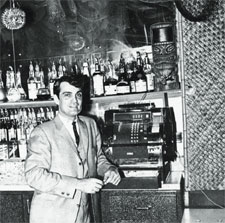
Dean Constantine. Photo from Secret Stash
FINDING ITS NICHE
The first ad in the Minneapolis papers appeared on November 13, 1966. The place started by featuring Latin rhythms. The first act was Herb Schoenbohm. Relieving him on Tuesday nights was Connie Hechter’s Afro-Cuban Sextet.
In January 1967 there was a change in Latin bands, with rotating rock bands on Sundays.
In mid-February 1967 the whole schedule went rock. A variety of rock bands went into rotation, and the Trashmen played the last two weeks of March 1967.
Photos below from Secret Stash
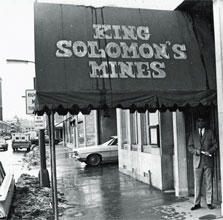
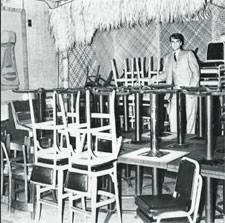
R & B DOWNTOWN
In April 1967 it began booking R&B acts, making it the only venue for black music downtown. Will Jones reported that it had had a change of management and was looking for a new name. In 1967 the club brought the “Latest and Greatest in rhythm & blues, including SKATE and BOO GA LOO,” went an ad in the Spokesman.
Groups in rotation in ’67 were:
- The Fabulous Amazers
- The Infinites
- Dave Brady and the Stars
- The Majors
- The Sages
- Maurice McKinnes and the Blazers
- Mr. K and the Soul Kicks
- The Niles
- King James and the Disciples
- Twistin’ Harvey Scales and the Seven Sounds. With a hit on the charts, this was an expensive act to book, but Constantine booked him at the Marigold on two Fridays so that patrons under 21 could see him and he could make more money so he wouldn’t have to raise the prices at King Solomon’s Mines. Will Jones reported that Scales introduced a dance called the Get Down (pronounced the “Git Down”) that really got the crowd going.
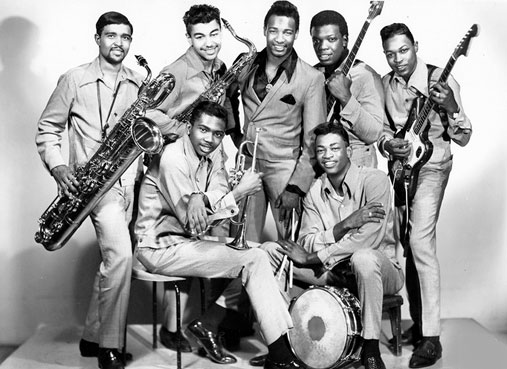
Harvey Scales and the Seven Sounds
- The Exciters
- Gene Williams and the Backsliders
- Jimmy and the Royal Knights
- The Incidents
- Henry Peters and the Imperials
- Show Time, Parts 1 and 2
- Wee Willie and the Exciters
Carole Martin, backed by the Bill Blakkestad Trio, entertained on Sundays.
In a column dated July 31, 1967 (right after the North Side riots), Will Jones remarked:
Despite all the lip service given to integration, and all the laws designed to bring it about, there’s precious little of it in the Twin Cities saloon scene, and in the heart of downtown Minneapolis it’s almost unheard of. That’s why it’s so heartening to see the development at King Solomon’s Mines … The crowds that have been gathering there in recent weeks are as nearly cosmopolitan in their makeup as we’re likely to find in these parts, with a range of ages as well as colors among the clientele. What’s bringing all the people together is a rhythm-and-blues group called The Amazers, who produce a sound to match their name. It’s a beautiful, swinging scene. So beautiful that operator Dean Constantine says his landlords have been making nervous noises about it. This is, however, a small sample of where it’s all at for the future, and should be now. It’s a time for nervous landlords to take a few tranquilizers and allow themselves to be amazed not only by the Amazers but by the amazing young among their following, who already have the whole thing straightened out neatly in their heads.”
The following photos are from an article by Minneapolis Tribune writer Allan Holbert, entitled “Rhythm and Blues is Back – Soul Sounds are Felt, Not Defined.” The band pictured is Gene Williams and the Backsliders, a road band. The article appeared on December 3, 1967, and the photos were taken by Tribune staff photographer Mike Zerby.
From a column from November 1, 1967, by Jim Klobuchar, it may be a good guess that the woman dancing is Chris.
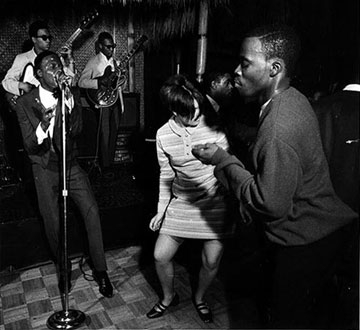
Photo Courtesy Minnesota Historical Society.
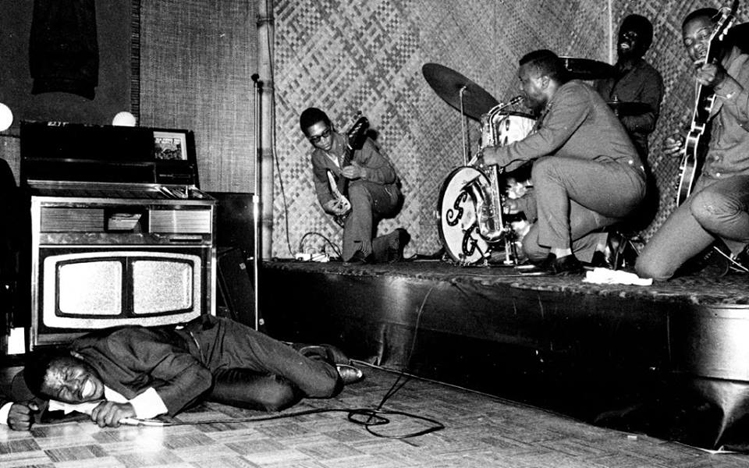
Photo courtesy Minnesota Historical Society
PROBLEMS
On Sunday, October 13, 1968, there was a note in the paper that a new Sunday liquor law was going into effect that day, but that Constantine was planning to continue his Sunday 3.2 beer policy.
On October 16, 1968, something called the Minneapolis Morals and Flying Squad raided King Solomon’s Mines looking for underage drinkers and found 10. One of the girls also had marijuana on her. Constantine said he bent over backwards to screen out the under-21 crowd, and had turned away hundreds and hundreds of kids. The Backsliders were playing that night.
In November 1968 the City Council was debating whether to suspend the club’s liquor license for 60 days, force Constantine to sell the club, or shut it down permanently, the last two as advocated by Alderman Jens Christenson. Although Police license inspector Harvey Everson described it as “the worst run place in the city,” the report in the Minneapolis Star on November 7 seemed to indicate that the only reason for the action was the arrest of the underage drinkers in October; a point was made that the 10 people arrested constituted 5 percent of the customers that night. The decision was made to suspend the liquor license for two months starting on November 11, 1968.
SECRET STASH
In Twin Cities Funk & Soul, Volume 1, Issue 1, September 25, 2012, page 29, there is a fine article about King Solomon’s Mines. Although I do not have permission to reproduce it, I will do so here in the interest of spreading the word about this important Minneapolis venue.
Secret Stash:
In the December 18, 1969 issue of The Minneapolis Spokesman there is an extensive interview with Dean Constantine about the closing of his club … In the short tenure of King Solomon’s Mines, Constantine hired black rhythm-and-blues bands and attracted crowds that were 90 percent black. The real reason he was closed, he figures, was that the white tenants in the Foshay Tower and in surrounding buildings simply did not want blacks in the neighborhood.
Constantine:
The raid that found the minors there was just an excuse. We always had two people checking IDs, and we often turned away 30 or more people a night because we didn’t believe they were 21. We wanted an off-duty policeman to work at the door, but we couldn’t find one who was willing.
Secret Stash:
(Clubs that hire off-duty policemen as bouncers are seldom raided.)
It shouldn’t be glossed over that there were real problems with violence at King
Solomon’s Mines. Dean Constantine recalls more than a few incidents. “Once in a while big Cadillacs would pull up and the trunks would open, then out would come the baseball bats.”
One event in particular that shook Dean happened as they were closing for the night. “A guy pulled a gun on my bartender and the place went silent. My bartender, who was a big guy that looked like Belafonte, started slowing walking toward him. The guy with the gun told him to stop or he would shoot, but he kept walking. When he got to him, the gunman just handed over his gun.” People against King Solomon’s Mines back in the day could say, “When black bands play downtown, black crowds come and there are more problems,” but they would be overlooking something important. King Solomon’s Mines was the only club downtown that catered to the black community. Because It was the only one, all people, upstanding citizens as well as less than upstanding ones alike, came to the club. It’s likely if there had been more clubs like it, each club on its own would have had fewer problems.
When talking with members from local R&B groups from the sixties, King Solomon’s Mines and The Cozy Bar come up far more than any other clubs. Donnell Woodson from the Exciters remembers, “King Solomon’s Mines was a new venue, a crossover for both black and white. Dean Constantine was the door opener.” Another Exciter, Herman Jones states, “The first guy that gave us a break to play in Minneapolis among the white population was Dean Constantine at King Solomon’s Mines. Dean went to the state capital to fight for us – that we should be able to play downtown and in the suburbs. We were one of the few black bands that were playing for white and black audiences.”
Dean himself has become a very revered figure to the musicians and it’s easy to
see why. Ricky Washington says when he was 16 he was playing drums with Billy Holloman at King Solomon’s Mines. He got arrested in a raid and it was Dean Constantine who bailed him out. And Ronnie Scott from the Infinites and Blazers recalls, “Dean Constantine had a thing for the help and the bands. If you did so much business, everybody got bonus checks, which was rare.”
Describing King Solomon’s interior, Anthony Scott from Prophets of Peace
remembers, “They used to have the room set up like you were in Africa. It looked like a jungle, it was real cool.” The club obviously left an impression on Jack Harris from KUXL/Black & Proud Records because once he moved down to Omaha to work at a new radio station, he opened a club with the same name. It even had a picture of a Pharaoh as you entered the door, and mirrors on the walls. Dean Constantine had a career as a dance instructor before running King Solomon’s and continued long after the club shut down. His daughter Deanna continues the dancing tradition.
HIS AND HERS
Constantine threw in the towel and sold the bar to William M. Roslanski and Stuart Z. Schwartz. Bill Roslanski owned the South Barn in Eden Prairie, and Schwartz was a sales manager at KMSP-TV (Channel 9). The transfer of the liquor license was approved by the City Council in January 1969. Constantine became the manager of the Friar’s Club.
Roslanski and Schwartz renamed the bar His and Hers, which opened on February 10, 1969.
Wantads for cocktail waitresses required that applicants be attractive.
In 1969 some of the bands featured were:
- Gregory Dee and the Avanties
- Sages
- Danny’s Reasons
- Del Counts
- Underbeats
- Mystics
- The City Limits
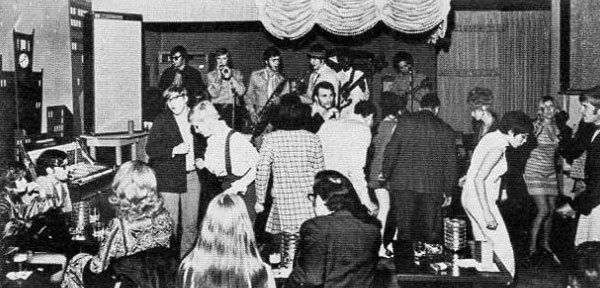
The Mystics at His and Hers, 1969, from the Insider.
By 1969, school dances were cutting into the profits of teen clubs, according to Roslansky. Ads for His and Hers disappeared from the Minneapolis papers in about July 1969. The Insider reported that bands were replaced by a juke box, and Roslansky sold the club to Burt Grossman in September 1969.
THE ESTABLISHMENT
The Establishment was a disco that was opened in late 1969 by Burt Grossman, scion of Grossman Chevrolet. It featured a stainless steel dance floor and had a predominantly black clientele, especially on weekends (Minneapolis Tribune, November 27, 1972). Grossman went on to own the Hippogriff and the Little Prince.
It’s impossible to search for the word “Establishment,” especially if the word is crumbling, but I was lucky to find this:
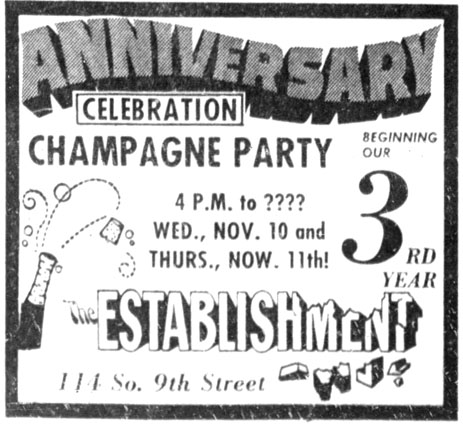
November 10, 1971
I have no idea of a timeframe, but the space was Cork’s by January 1980.
Grossman sold the Establishment in 1977 when he opened the Little Prince Restaurant.
CORK’S
There is evidence of Cork’s from at least January 1980.
PETER’S GRILL
had to move in 1985, and its new address was 114 So. 9th Street, at least until 1990.
CAFE UN DEUX TROIS
was owned by Chef and New York transplant Michael Morse and opened in May 1992. Music and dancing! It closed on April 5, 1993 and declared bankruptcy that November.
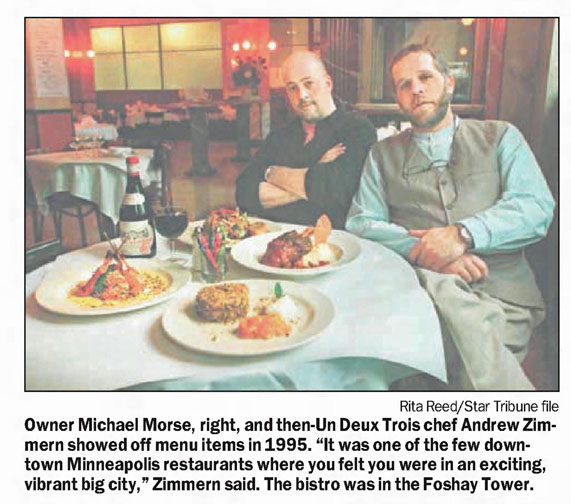
StarTribune, April 8, 2003
RED
was a Russian-themed restaurant that replaced Un Deux Trois in March 2004.
KEYS CAFE
Moved from Nicollet Mall @ 2011.
